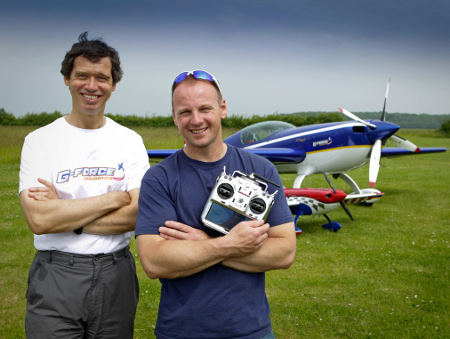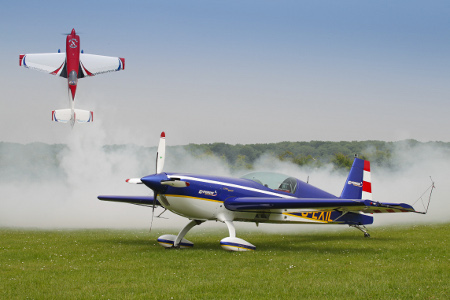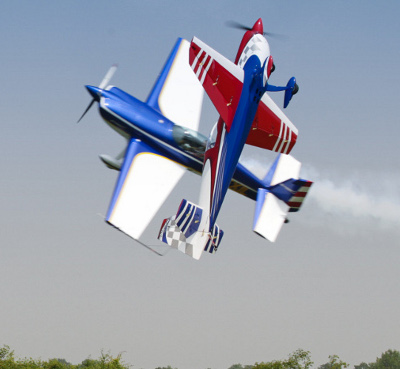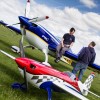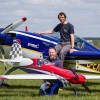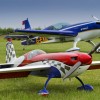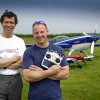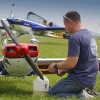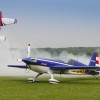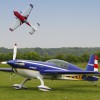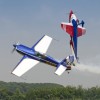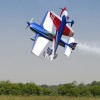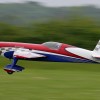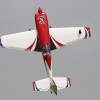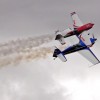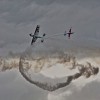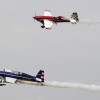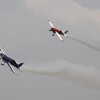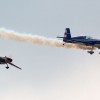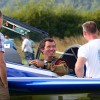Extra, extra!
This article, written by Chris Burkett, first appeared in RCME magazine, September 2013
Aerobatic pilots Chris Burkett and Mike Williams compare the full-size and 41% scaled model versions of their favourite workhorse. Chris takes up the story…
The Extra series of aircraft, designed by German aerobatic pilot Walter Extra, has had a huge influence on aerobatics – they have helped to redefine what it’s possible to do in a full scale aerobatic machine. The most common variant is the two seat 300L, which allows Unlimited level aerobatics to be performed whilst carrying a passenger. The 300S that I usually fly is a lighter, higher performance single-seat variant. Both are extremely strong and certified to g-limits of +10 to -10 (10 times the force of gravity). The pioneering carbon-fibre wing spar is incredibly stiff and strong, designed to an ultimate failure load of 24g – at these extraordinary stress levels the weakest point in the system is likely to be the pilot!
The Extra 330SC is the latest version, on which Mike’s 41% scale model is based. This adds another notch to the performance, thanks to almost 50kg of weight saving, 20hp more power, and redesigned control surfaces. It won the World Aerobatic Championships at Silverstone in 2009 in the hands of Renaud Ecalle, and again in Texas in 2013, flown by Francois le Vot.
A single seat Extra is a fantastic, responsive, and exhilarating machine to fly, and I always feel privileged to do so. However I still look with envy at the amazing scaled performance and thrust to weight ratios possible from current models. The performance of a full scale Extra can feel breathtaking whilst you are sitting in it – especially if you are used to more pedestrian flying machines. But a glance at Mike accelerating vertically upwards from the hover leaves no doubt that he has significantly more performance on tap – how I would love to be able to do that in the real thing!
The Big One

I can give you a brief personal impression of what it is like to fly the Extra. When the controls are kept near the centre of their travel it is an ‘easy’ (if responsive) aeroplane to fly and, more or less, vice free. Once your brain has adjusted to the pace, take-offs and landings are straightforward and more forgiving in this respect than the Pitts biplane, for example. Operating the aeroplane ‘gently’ is entirely possible – but this would be a terrible waste.
The Extra is such a willing performer that it begs to be pushed (and pulled) hard and, at the limits, it is more than capable of inflicting pain. Despite feather-light control forces during normal operation, in a display sequence I sometimes have to use both hands on the stick to accurately position the controls under very high loads. In negative flicks and some tumbles it feels like your head is being ripped off your body. Yet even whilst doing so the aeroplane remains highly predictable once you’ve learnt its ways. Huge control authority can get you into manoeuvres quickly, but they also help to get you back out again.
No Escape from the Physics
When we scale down the model, we would expect it to be much livelier to fly than the full-size aeroplane – as every model flier knows, their models are twitchier and more of a handful than the real thing. It also means, for example, that starting and stopping rolls crisply in the full scale aircraft is harder compared to the model, due to the much higher inertia. So if some manoeuvres look less crisp than you could manage on your model, blame the physics and not necessarily the pilot!
I’m an occasional attendee at our local flying field; watching the aerobatics there, the apparent levels of ‘g’ being pulled by the models make me wince as I imagine what it would feel like to do that sitting in the cockpit. The difference, once again, is down to the scaling laws. For a model flying at scale speed and flying a loop with scale radius, the g force will also scale linearly. So this means that if a 20% model flies a 5g pull to or from vertical, it looks to me like the equivalent of a 25g pull. Ouch!
Using more g than you need to in the full scale aeroplane is generally a bad idea. As well as being tiring (and leading ultimately to unconsciousness) it kills the energy of the aeroplane too. Fighter jets can sustain 9g for extended periods (by starting fast and having high thrust to weight). Aerobatic planes like the Extra can pull and push to very high g levels, but sustaining it bleeds energy very rapidly, due to the large amounts of lift induced drag – the drag scales with the square of the g-force loading, so 9g gives 81 times as much induced drag. During an aerobatic display I am usually flying to about +8g/-5g, but the peak g levels are not sustained for long – we don’t have pressure breathing and anti-g suits like the fighter pilots, either!
In the Seat
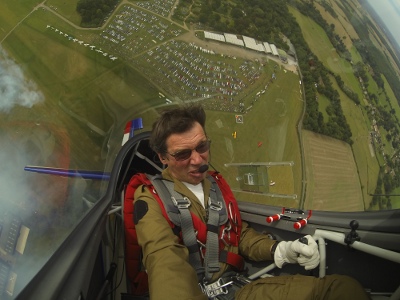
Compared to the model, flying the real thing is a full body experience – your senses are being assaulted, and often disoriented. You can feel the balance and accelerations of every manoeuvre through the seat of your pants. However, at display intensities this feedback can be too much of a good thing and gets taken to pain inducing levels. The whole performance becomes very physical – hard negative g results in deep hip bruising from the harness. Likewise it’s hard to stop your upper body being thrown around so I tend to have semi-permanent bruising to my upper arms from being thrown against the cockpit sides. Withstanding the g is a physiological hassle – having to fight against losing consciousness is not good for your concentration! Executing the sequence as a whole whilst managing matters such as timings, positioning and radio is a little like playing a game of chess, whilst trying to focus on flying accurately, and simultaneously going a few rounds with Mike Tyson in the boxing ring!
All of this helps to explain why flight simulators aren’t really much use for learning full scale aerobatics. In contrast model flight sims can replicate the visual feedback needed to fly a model very well, and I’m impressed with just how good they seem to be.
Two other major differences between model and full scale spring to mind: cost per flying hour, and the consequences of a miscalculation! Both of these mean that full scale aerobatic experience is very hard won.
Comparing Tricks
Knife edge flight in the Extra is fun, but trickier than in some other aerobatic machines. For example, the Pitts is superior in this respect, and will happily maintain knife flight for extended periods. A knife edge pass in the Extra is something I do a lot, but it is quite hard work – watch out for a decaying airspeed and, after several, a shaking leg!
The different behaviour between model and full-scale is most apparent in flick rolls and spins, a function of the much higher inertia. A flick roll involves stalling one wing with aggressive rudder application. In the full scale aeroplane it is essential to ‘unload’ a positive flick with full forward stick after initiation, otherwise the flick will peter out due to excessive drag and decaying airspeed. Forward stick also brings the heavy masses in the plane (like the engine and the pilot) back onto the rotational axis, which speeds up the rotation – a bit like an ice skater pulling their arms in during a spin. Likewise in a spin, the build up of yaw inertia is much more significant full-scale, and the position of the ailerons and elevator is critical to determining the type of spin and the manner of the recovery. Application of opposite rudder may not be enough to recover; there was a recent case of a small aerobatic plane, the Tipsy Nipper, which took 26 turns to recover from a spin which had ‘gone flat’!
With recent high performance aerobatic machines like the Extra it has been possible to create a new class of manoeuvre, known broadly as tumbles. The plane can be yawed so that it is travelling completely sideways, whilst tumbling in a tight outside loop end over end. This can be achieved whilst going vertically up, vertically down, from the top of a loop, or even straight towards the crowd. These manoeuvres depend upon gyroscopic precession, the peculiar property of a spinning prop where any force applied to it gets precessed and returned to the airframe at 90 degrees to the original direction. Hence a rapid pitch with full power will induce a yaw, and vice versa. This is why tumbles, knife edge spins and flat spins become possible – aerodynamics are not enough, we need to exploit gyroscopics! An Extra is very good at these so various tumbles (up, down, towards you), tailslides and torque rolls plus hesitation aileron rolls and flicks form the basis for my display.
The Small One
My Extra 330SC is designed after its full-size counterpart by the Czech company Krill Aircraft. The airframe is fully composite, comprised largely of carbon-fibre. The design has been tweaked in order to cope with demanding 3D manoeuvres which are now the norm for freestyle flying. The wing planform follows the full-size, however the model features much larger ailerons both in chord and span. It also uses a significantly different aerofoil section. The leading edge is much sharper than full-size and this gives a much cleaner break into post stall manoeuvres like the harrier.
One of the reasons I can do manoeuvres like the harrier is because my Extra flies with a much lower wing loading than Chris’. This makes the 41% machine incredibly forgiving and allows me to prop-hang at between 30% and 50% throttle. Full power results in an impressive acceleration out of the prop-hang and vertical lines can be extended indefinitely or until out of sight.
Power is provided by a 175cc flat twin two-stroke MVVS petrol engine, where each cylinder feeds into its own tuned exhaust canister system. This not only controls engine noise but also provides more linear throttling characteristics. In order to perform extreme 3D manoeuvres the control surfaces have around 60 degrees of available movement and are fully utilised when 3D rates are on.
Freestyle flying isn’t just full-on 3D, it also incorporates smooth aerobatics at which the Krill Extra also excels. There are, however, some manoeuvres which Chris can perform that I can’t replicate – mainly any manoeuvre which requires a large amount of gyroscopic force; with a lightweight carbon-fibre prop and lower inertia, the gyroscopic effect is drastically reduced.
Overall, the Krill Extra 330SC is incredibly forgiving, although, like any aeroplane, there are limits to its flight envelope that must be respected.
Mike Williams
What tends to be less satisfactory in an Extra is the ultra low speed high angle of attack stuff – the cobras and harriers. The Russian Sukhois are better at this. If I had scale model levels of thrust to weight ratio … now that would be another matter! Much as I would wish it to be true, the thrust to weight ratio of my aeroplane is not greater than 1:1 – in fact at about 0.75:1 it is a good deal less. Hence hovers at the top of vertical manoeuvres are a rather transitory affair – gravity gets me in the end. Vertical penetration is very good but certainly not indefinite. Vertical climbs of more than 2500ft, complete with multiple vertical rolls, are the norm – but from a high speed entry, not from a hover!
If money were no object it would certainly be possible to create a new aero engine with a lot more power. The engine fitted to the Extra aircraft, and indeed almost all other non-Russian aerobatic machines, is the rather venerable Lycoming, a very reliable (and conservative) horizontally opposed, air-cooled four-stroke. The O-540 series engine has six cylinders and a capacity of 8.86 litres, and is rated in the range 260 to 320 BHP at 2700rpm. Its installed weight is around 200kg.
Energy management is everything during a display, because it’s very time consuming to get it back again once you’ve lost it. In practice this generally means being low and fast, or slow and high, but not low and slow, other than for passes at the end. In comparison to the more powerful and more draggy Russian Yaks and Sukhois, an Extra is quite slippery and holds its speed well. It prefers flying at higher speeds, so g levels tend to be higher, in order to avoid spreading the display across three counties. It’s surprising how much space typical manoeuvres take up. For instance, the diameter for one of my loops is around 400 metres, so with turnaround figures at each end, the challenge is squeezing everything in and remaining in front of a crowdline which may be anything from 500 to 1000 metres long.
Positioning is one of the most critical and difficult aspects of display flying. When I pull up to perform a vertical manoeuvre like a torque roll, the whole manoeuvre can easily take 30 seconds. If there is a strong on-crowd wind I will have been blown several hundred metres in the process. The display axis for aerobatics is (at a minimum) 150 metres from the crowdline. Without forethought you may exit a manoeuvre over the crowd – dangerous and rightly frowned upon by the CAA. Hence whilst being bashed around in the cockpit, you need to keep a very careful check of your position and, like a game of chess, plan ahead by at least a few moves.
Mike Williams
Mike is what you’d call a ‘total aviation person’, starting model flying at the age of nine. Taught by his father, by ten he was flying aerobatics with a Fun 3 low wing model. The usual suspects soon followed: Acro Wot, Panic et al and, eventually, 40% scale freestyle machines. Mike’s rise through the competition ranks has been steady, progressive and rock solid, a result of dedicated practice, determination and graft. His achievements are numerous and, thus far, include: British Freestyle Champion, Top Gun Aerobatic Champion (twice), numerous wins in F3A FAI Class pattern aerobatics, F3A Advanced Class National Champion, and Unlimited Class UK Shoot-Out Champion.
| DATAFILE | 41% Krill Extra 330 | 100% Extra 300S | 100% Extra 330SC |
|---|---|---|---|
| Length (m) | 2.9 | 6.65 | 6.7 |
| Wingspan (m) | 3.1 | 7.5 | 7.5 |
| Wing area (sq. m) | 1.7 | 10.4 | 9.8 |
| Weight (kg) | 17.7 | 750 | 700 |
| Power (BHP) | 20 | 300 | 320 |
| Never-exceed speed | N/A | 220 kts | 220 kts |
| Max crusie speed | N/A | 170 kts | 170 kts |
| Thrust to weight ratio | 2.5:1 | 0.75:1 | 0.85:1 |
| Price | £6500 | IRO £160000 | IRO £275000 |



